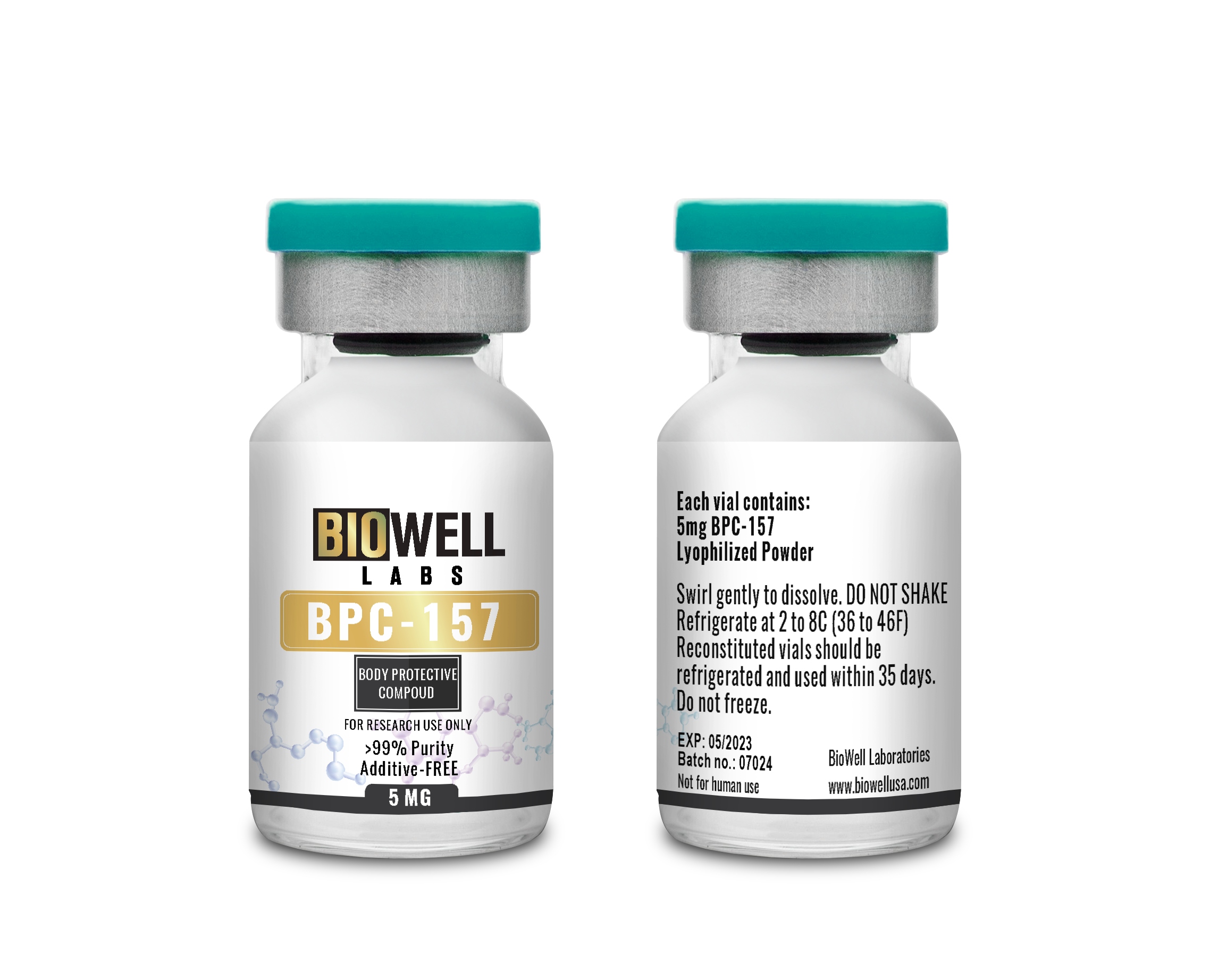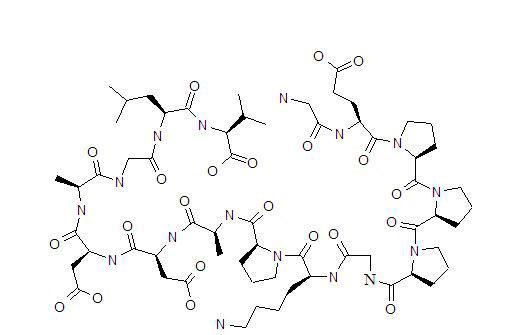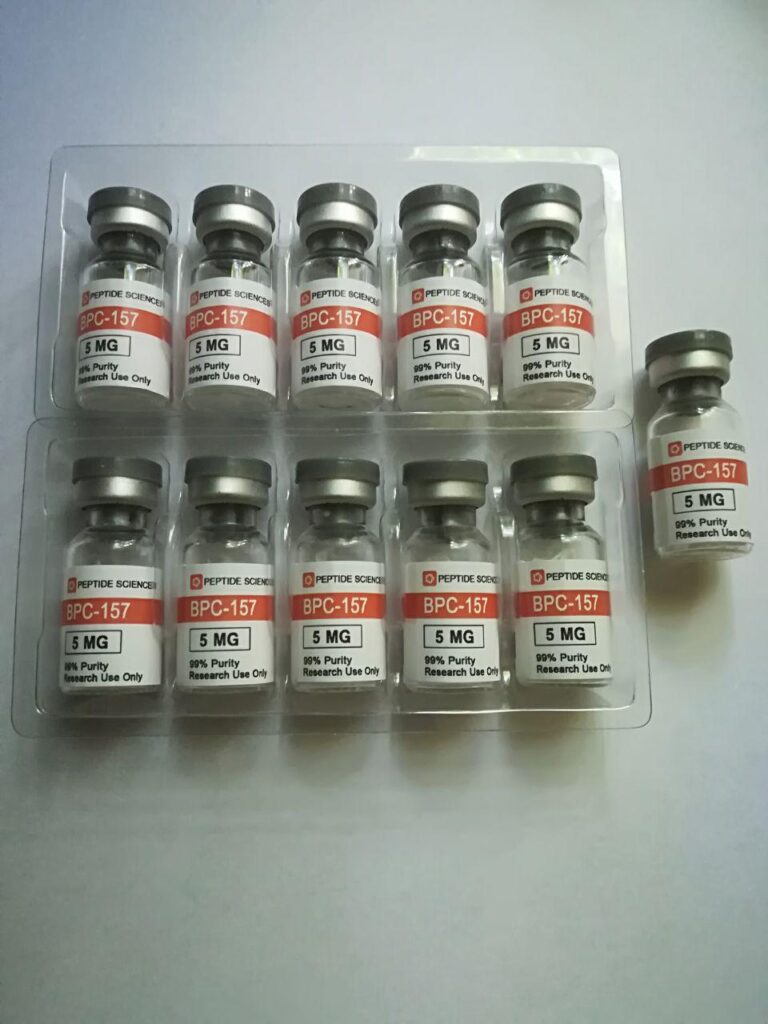
A short peptide chain bpc 157 is attracting attention from scientists all over the world due to its potential as a regenerative for muscles. Initially discovered as a protein found in stomach acid, the 15-chain long amino acid fragment has tremendous therapeutic potential in the body. Here in this article, we’ll look at what this peptide chain can do for you and the research surrounding it. Let’s take a look.
What is BPC 157? Our Buyer’s Guide

Bpc157 is a pentadecapeptide and a peptide, i.e. a short sequence of amino acids. Amino acids can be found naturally in the body, however, this one is produced synthetically.
In detail, this peptide is a sequence of 98 hydrogen, 62 carbon, 22 oxygen, and 16 nitrogen atoms – put together, the nitty-gritty chain is spelled out with the following molecular formula:
C62-H98-N16-O22
So much for the fancy formula, but what’s with the name? If you’re curious, the acronym in bpc peptide stands for “Body Protecting Compound”. The body naturally produces BPCs in the gut and stomach which serve to protect the organs from the unwanted activity and helps them heal. The great news is that wherever you put these compounds in the body, they will bring about regenerative properties.
How Does BPC 157 Work?
The bpc 157 peptide triggers the formation of new blood vessels, promoting tendon growth and muscle healing. This is a natural process called angiogenesis, used by the body to help it heal from cuts, wounds, and any damage from trauma.
Examples can be found all over the body. Studies, for example one conducted by Xiaoming et al, show that the compound can help reduce Inflammatory Bowel Disease by helping the inflamed lining of the gut heal up. Other studies from the Journal of Orthopedaic Research as well as Chang et al show that bpc-157 causes tendon cells to heal and grow because they increase growth signaling molecules, block growth-inhibiting effects from other molecules, and reduce inflammation in the body. The brain is an organ also positively impacted by the substance – research shows how it regulates the production of dopamine and serotonin, helping people deal with seizures, depression, and pain.
BPC 157: Benefits and Side Effects
With a lot of potential promise, let’s examine both the benefits and bpc 157 side effects. When you do your research, you will notice a lot of interesting benefits of using bpc 157. However, any substance that you take, no matter what it is, brings about a biological cost and benefit. There is no perfect solution in biology, and the human body is a complicated thing, so let’s consider the evidence surrounding the use of bpc 157 tablets and powders.
Benefits
The Brain and nervous system
Exciting studies on animals from the journal Regulatory Peptides found that BPC 157 injections help to reduce brain damage, the physical effects of trauma on the brain and ultimately helped the animals stay alive for longer. In recent research undertaken on rats, the product results in an overall decrease of traumatic nerve injury and has even been found to positively affect the mood of such animals. Scientists have even likened a comparable effect to conventional antidepressants.
Cuts, Burns and Broken Bones
Research from the Journal of Physiology-Paris has found that the compound is a potentially useful therapeutic agent for trauma when tested using different experimental treatments on animals. Experimental models, mainly done on rats, show that the substance turbocharges the healing process in tissues and bones. Other studies on rabbits note how it can be used to heal broken bones, and with our DNA makeup not too far away from either animal, there is a promise for humans too.
Pain relief
Studies have found that the effects of taking bpc 157 are mild and beneficial. Although it does not provide pain relief comparable to substances such as morphine or aspirin, the substance has been found to decrease the susceptibility of pain in animals, particularly the animals were pinched or subjected to unpleasant stimuli.
Regulation and Balance of Blood Pressure
Although studies have not yet been carried out on humans, anecdotal accounts in various bpc 157 reviews point towards the benefits of decreasing blood pressure, so what’s the deal there? Recent bpc 157 results in animal testing studies show that it does in fact stabilize animal blood pressure. Animals given a chemically induced high blood pressure were given injections, and findings show that these injections decreased blood pressure overall. The results are something to think about, especially how the tested animals share 97.5% of the human genome.
Balancing levels of potassium
When the body has a level of potassium that is too high and the blood, this can cause fatigue, muscle weakness, and irregularities in the heart that can lead to death. Fortunately, studies such as those carried out in the journal Regulatory Peptides show that animals given injections of BPC 157 had a better chance of survival when subjected to unhealthy doses of potassium in the blood. The injections significantly prevented animals from dying, whereas those that did not receive the injection died in half an hour’s time.
Intoxicating Effects of Drugs
Drugs are often highly intoxicating for the human body. Bpc 157 administered in scientific testing helped counteract chemical imbalances in animals after they were subjected to amphetamines. Similar studies have been carried out on animals given morphine, where bpc 157 decreased the intoxicating effects. Doctors around the globe often struggle with intoxicating effects when treating patients as the effects can often lead to greater problems down the line.
Side Effects
Every human body is different, and every taken substance will produce an effect. So it is very important to consider the various side-effects of this peptide and how they may impact your health.
Common side effects include the following:
● Weight gain (not ideal for weight loss)
● Suppression of satiety
● Liver toxicity
● Cancerous cell growth
● Blood pressure change
● Dizziness and fatigue
● Heart palpitations
● Toxins passing to foetuses
It can be very beneficial for the body to grow new blood vessels, treat injuries, and experience pain relief, however, there can be dangerous risks, especially associated with cancer. Although no studies have yet suggested that BPC 157 increases a man’s risk of cancer, it is important to consider. Some studies have even shown that BPC 157 can be effective in a therapeutic manner for cancer patients who experience wasting of muscles. However, the risk is perceived to be largest when there is already cancer in the body, as increased blood vessel growth can feed a tumor much faster, causing them to spread more easily.
We highly recommend speaking to your doctor before taking any peptide. Side effects are often the result of improper use or dosage, so it’s best not to risk it and consider the best practices for taking the product.
Dosage and Cycling
As of yet, there are no peer reviews of trials that have examined bpc 157 dosage on human beings. In addition, the Food and Drug Administration has not approved the substance for treating conditions in humans, nor have they prescribed guidelines on recommended doses. Most of what you will hear about doses from manufacturers is based largely on unscientific trials.
However, even though there are no clinical trial results for humans, a maximal dose of around 600 µg for a 132-pound human is a good starting point. This data, which can be scaled up or down depending on your weight, comes from the best of those practices on other animals that are found in studies from the likes of Kang et al. and others. These are numbers based on what you might take in a single dose.
It is important that you consider the implications of taking the substance because scaling doesn’t often work well between different species. For instance, some people may take around 250 µg a day for pain relief, whereas others may take much less. The aforementioned studies were also carried out using injections, rather than administering the drug orally, which is the common practice for humans. Some people do inject the substance, but it is uncommon.
As with any substance, to take it at your own risk. The doses discussed are guidelines, but they are not 100% scientific. As with any information you read, question its authenticity and always talk to your doctor before taking BCP 157.
Inject BPC 157 or Take It Orally?
What’s the best way of administering this substance? Do you go for injections or bpc 157 nasal spray? Some people even use a bpc 157 patch. The most important thing to note is that BBC 157 will work regardless of the method you use.
Just like is carried out in the majority of scientific studies, you can inject the substance subcutaneously, i.e. application just under the skin. This is a relatively easy and pain-free method compared to intramuscular injection, whereby you need to start the needle right into muscle tissue. Both of these methods work best when applied as close to an area of pain as possible if you are looking to use the substance for pain relief. If you are okay with needles, make sure you pension the area of skin first that the needle can enter the body more easily. After injecting, make sure that you clean the area thoroughly with an alcohol-based swab, to reduce any chance of infection.
If you’re into peptides bodybuilding but can’t stand the sight of needles, a bpc 157 oral administration is possible. You can either take a capsule or spray a thin mist of the peptide into your mouth. We recommend holding the peptide in your mouth for at least a hundred seconds before swallowing.
Limitations and Caveats
If you research bpc 157 capsules and the science behind them, do bear in mind that clinical trials on humans are rare, if not very small, and confined to experimental settings. The studies that we have discussed are all administered on animals in laboratories, and although such information is certainly valuable, animals are not humans.
While it certainly isn’t a shock to see the outcomes of this product in laboratory settings, it is worth noting that research on humans is currently in the pipeline and we can’t expect to see mass clinical trials conducted any time soon. Any studies or evidence you read regarding bpc 157 and animals can only be scaled up to humans to a certain degree.
Feedback From Real Users

When you look at any bpc 157 review, and read pieces on “tb 500 vs bpc 157” or related matters, it’s important to bear in mind that the opinions are expressed solely on an anecdotal level and should not be taken as hard scientific fact. You certainly do not endorse any specific treatment, product, service, or method that hasn’t been studied extensively by scientists.
No matter how much you would like to believe it, the hard-line is that a user’s experience never counts as medical advice. This is why you should never refrain from asking a doctor or healthcare professional when taking any substance for yourself. Of course, there are a multitude of real-life sources out there that can certainly give you a good overview of bpc 157, but it should never be taken as gospel.
That said, the vast majority of users are positive about the product’s effects. If you look at various professional opinions on muscle forums, users report that the product helps with their soreness, injuries, tendinitis, inflammation, and many other ailments.
However, some people report no significant benefit from using the product. Others are also wary of the high costs involved, but prices do vary depending on sources.
Many are also confused about how to use it and the recommended dose. In an extensive review of forums, we found some people reported getting unpleasant side-effects, but it did not make up the majority of reviews.
It is important to note that the number of users have raised issues about companies and mislabelling peptides but are cheaper to produce as bpc 157. This is a worthy concern, and we urge you to only choose from the most reputable companies if you are to purchase the product yourself. Not everything on your average bpc 157 buy online page does exactly what it says on the tin.
Concluding Remarks
Now that you’ve read all about the peptide bpc-157, you may be wondering why this natural substance, similar to what is found in natural gastric juices, isn’t on the market yet. The key is that it can’t be patented at all because it is a completely natural gastric juice peptide. Large pharmaceutical companies aren’t able to make a lot of money because their investments are not protected and anybody can make the product. The result is that it slows down approval from the Food and Drug Administration. It even prevents this organization from considering it to be sold for human use, although things may change over time.
Unlike a variety of other peptides, the good news is that BPC 157 is not bound by respected sports bodies such as WADA. This means that if you’re an athlete looking to reap the benefits, bpc-157 is legal to take before sporting events, for the time being at least. There is no way of knowing for sure what the future will bring, but it is unlikely to be banned for many years to come. In the meantime, no significant adverse effects have been found in any short-term studies in humans.
In summation, there are a number of well-documented bpc 157 benefits, from regenerative properties to healing tissues and protecting organs. Although more research needs to be done, the product works in a variety of different animals, and many thousands of users around the world swear by bpc 157 for helping them build muscle and rid themselves of various ailments.
Article compiled using information from the following sources:
- https://www.ingentaconnect.com/content/ben/cpd/2013/00000019/00000001/art00005
- https://onlinelibrary.wiley.com/doi/abs/10.1016/S0736-0266(03)00110-4
- https://journals.physiology.org/doi/full/10.1152/japplphysiol.00945.2010
- https://pubmed.ncbi.nlm.nih.gov/15840402/
- https://www.sciencedirect.com/science/article/abs/pii/S0167011509002341
- https://www.sciencedirect.com/science/article/abs/pii/S0167011509002274
- https://www.sciencedirect.com/science/article/abs/pii/S0928425797894806
- https://link.springer.com/article/10.1007/BF02659088
- https://www.sciencedirect.com/science/article/abs/pii/S0167011513000086
- https://pubmed.ncbi.nlm.nih.gov/11978191/
- https://www.sciencedirect.com/science/article/pii/S0968089617310222
- https://pubmed.ncbi.nlm.nih.gov/29898649/
- https://josr-online.biomedcentral.com/articles/10.1186/s13018-019-1242-6
